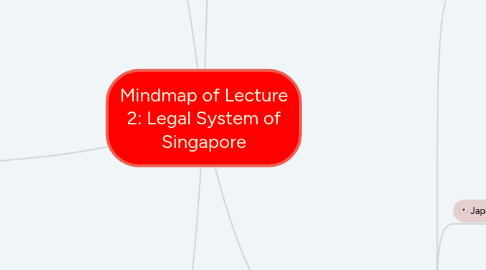
1. Independence
1.1. After separation from Malaysia, Singapore's Constitution was found in 3 separate documents,
1.1.1. 1. the Republic of Singapore Independence Act
1.1.2. 2. the Constitution of Singapore
1.1.3. 3. portions of the Federal Constitution of Malaysia made applicable by theRepublic of Singapore Independence Act.
1.2. The Singapore Parliament did not make any changes to the judicial system. The Singapore High Court remained a part of the Federal Court system of Malaysia, and appeals from the Singapore High Court continued to be made to the Federal Court of Malaysia.
1.2.1. Only in 1969 the Singapore Parliament passed the Supreme Court of Judicature Act. This Act took Singapore out of the Federal Court of Malaysia.
2. Courts part of Singapore's Legal Systems over the years
2.1. Present
2.1.1. 1.State Courts,
2.1.2. 2.Supreme court Comprised of High Court and Court of Appeal
2.2. Past
2.2.1. 1.Privy Council in London,
2.2.2. 2.Supreme Court of the Federation of Malaya
2.2.3. 3. Supreme Court of the Straits Settlements
3. Sources of Law
3.1. Written
3.1.1. The Constitution
3.1.1.1. In Singapore the Constitution is the supreme law of the country. This means that no one, not even Parliament, can do anything that goes against the Constitution.
3.1.2. English Law
3.1.2.1. Both statutes and cases made by the English judicial and legislative systems for the people of England. This is to be differentiated from laws made by the English for Singapore while they were our colonial masters.
3.1.3. International / regional Treaties and Conventions
3.1.3.1. International conventions can be made by whichever countries that choose to be part of the convention. These countries would come together at designated international forums and come to a final agreement acceptable to at least a majority of the participating countries.
3.1.4. Legislation
3.1.4.1. The process that a “bill ” goes through, before it is actually passed and made into a statute
3.1.5. Subsidiary Legislation
3.1.5.1. Subsidiary legislation are laws that are made by people or institutions empowered by Parliament to make such laws.
3.1.5.1.1. For example, SMOKING (PROHIBITION IN CERTAIN PLACES) ACT has Subsidiary Legislation titled SMOKING (PROHIBITION IN CERTAIN PLACES) REGULATIONS 2018 made with the approval of the Minister for the Environment and Water Resources
3.2. Unwritten
3.2.1. Common or Case Law
3.2.1.1. A body of cases and original customs decided by the judges over the years.
3.2.1.2. The common law system uses the use of judicial precedents
4. 3 Arms of the Government
4.1. The Executive
4.1.1. WHO
4.1.1.1. President, the Prime Minister and his Cabinet of Ministers, the Civil Service, the Police, and even the Attorney-General’s Chambers.
4.1.1.1.1. WHAT
4.2. Judiciary
4.2.1. WHO
4.2.1.1. President and Parliament.Parliament is made up of Members of Parliament (“MPs”).
4.2.1.1.1. WHAT
4.2.1.2. 3 different types of MPs *Elected MPs (who are directly elected by the people) *Non-constituency MPs *Nominated MPs.
4.3. The Legislaature
4.3.1. WHO
4.3.1.1. The Chief Justice and the other Judges of the Supreme Court represent the highest judicial authority in Singapore.
4.3.1.1.1. WHAT
5. History
5.1. Under British Rule
5.1.1. In 1866, the British Parliament passed the Government of the Straits Settlements Act. The Straits Settlements was ‘detached’ from India and was constituted as a separate colony with its own legislature.
5.1.2. The Straits Settlements was granted a ‘colonial constitution’. Legislative authority in the colony was vested in the Legislative Council.The Legislative Council was made up of:
5.1.2.1. 1. the Governor
5.1.2.2. 2. the Chief Justice
5.1.2.3. 3. the Officer in Command of the Troops
5.1.2.4. 4. the Lieutenant-Governor of Penang
5.1.2.5. 5. the Colonial Secretary
5.1.2.6. 6. the Attorney-General
5.1.2.7. 7. the Colonial Engineer
5.1.2.8. 8. 4 Unofficial Europeans
5.2. Japanese Occupation
5.2.1. Japan occupied Singapore from 1942 to 1945.All existing courts ceased to function. In their place, a Military Court of Justice of the Nippon Army was set up.
5.2.2. Several Japanese government or military bodies had the power to make laws – at the top of this pyramid was the Supreme Command of the Southern Army Headquarters.
5.2.2.1. Lieutenant-General Yamashita
5.3. Post-War Push for Independence
5.3.1. The Japanese surrendered on 12 September 1945. The British Military Administration temporarily administered Singapore.
5.3.2. Singapore became a separate Crown Colony vested with its own constitution. The judicial structure and hierarchy of courts was what it was before the War.
5.3.3. For legislative powers, 2 bodies were set up
5.3.3.1. the Executive Council: made up of 6 Officials and 4 nominated Unofficials
5.3.3.2. the Legislative Council: made up of 4 ex-officio members, 5 Officials, 4 nominated Unofficials and 9 elected members
5.3.4. In the1955 elections, the Labour Party led by David Marshall won 10 seats and David Marshall became the first Chief Minister of Singapore.
5.3.4.1. David Marshall was determined to wield real power and to change the government from that of a colony to a democratically and completely locally-elected one.
5.3.4.2. Lim Yew Hock succeeded Marshall as Chief Minister. He led a second all-party delegation to London to renew discussions on self-government.
5.3.4.2.1. Under the Singapore (Constitution) Order in Council 1958, the post of Governor was abolished and in its place, the office of Yang di-Pertuan Negara was established.
5.4. Merger with Malaya
5.4.1. The new PAP government of the State of Singapore sought merger with Malaya for 2 main reasons, namely, to achieve political independence and for economic survival.
5.4.1.1. Singapore was allocated 15 of the 159 seats in the new federal legislature and retained her own executive government and legislative assembly.
5.4.2. Control over foreign affairs, defence and internal security was left to the central government but control over finance, labour and education in Singapore came under the Singapore Government.
5.4.3. The High Court of Malaysia in Singapore replaced The Supreme Court of the Colony of Singapore. Together with the 2 sister High Courts of Malaya and Borneo, it became part of the Malaysian system of courts. At the top of the hierarchy was the Federal Court seated in Kuala Lumpur.
